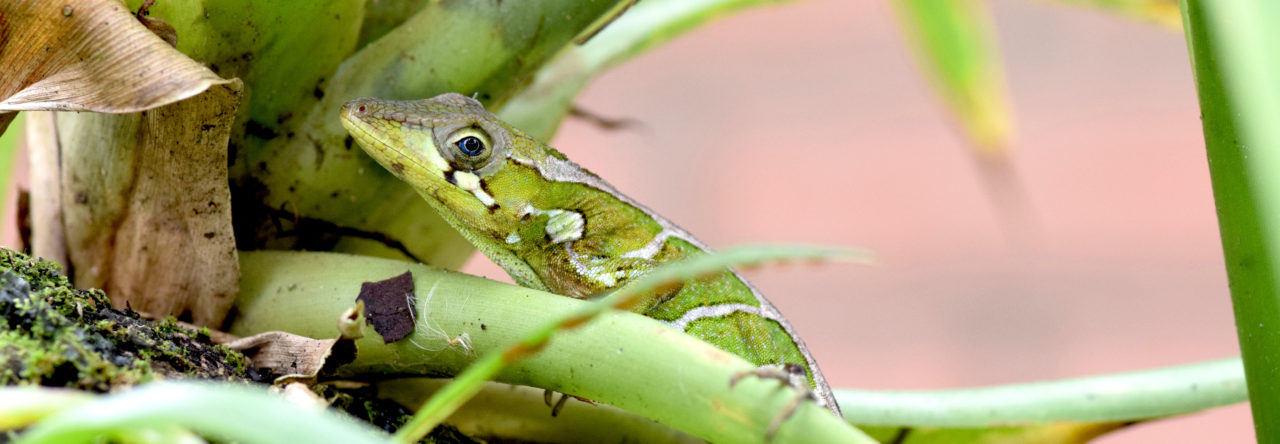In an earlier post on anole foraging mode, Jonathan Losos remarked that “much remains to be learned about the specifics of anole foraging and how it differs among species.” One thing we do know, however, about fine-scale variation in foraging mode is that it can depend on microhabitat. Both interspecific and intraspecific variation in movement rates in anoles suggest that low-perching anoles in trunk-ground habitats move less frequently than high-perching anoles in arboreal trunk-crown habitats (Lister and Aguayo 1992; Cooper 2005; Johnson et al. 2008)
One reason that anoles may shift from low to high perches is the presence of a congener. In the spoil islands of Mosquito Lagoon, FL, Anolis carolinensis occurs either on its own or in sympatry with A. sagrei, and recent research by Stuart, Campbell and colleagues showed that the green anoles perch higher on two-species islands than on one-species islands. Back in 2010 as a field assistant on this project, I collected some data on the foraging mode of green anoles on five of these islands, to test the prediction that allopatric A. carolinensis that inhabit lower perches in trunk-ground microhabitats have lower movement rates than sympatric A. carolinensis that occupy higher perches in trunk-crown microhabitats. I used the standard measure of movement per minute (MPM) to quantify foraging mode from a total of 204 lizards (78 females and 126 males, 110 lizards from one-species islands and 94 from two-species islands).
Movement data are messy and MPM varies a lot across individuals, with coefficients of variation within islands ranging from 41% to 74%. Moreover, when one watches lizards go about their lives, one readily realizes that they move for many reasons other than to feed and that MPM is therefore better interpreted as an index of activity than as a measure of foraging per se (Perry 2007).
I found that females show the predicted increase in MPM with increased perch height when sympatric with A. sagrei, while males show the opposite pattern, with higher MPM in the absence of A. sagrei (there was something of an interaction between A. sagrei presence and sex in the ANOVA on island means of MPM for males and females; F1,1=4.02, p=0.09).

Means of island means of MPM for male and female green anoles in one-species and two-species islands in Mosquito Lagoon, FL.
That males and females differ behaviorally in their response to A. sagrei is perhaps not surprising, as males and females have different motives for movement during the breeding season. Male anoles spend a majority of their time in the breeding season engaged in social interactions and forage only opportunistically. Females, on the other hand, spend most of their time foraging in both the breeding and the non-breeding seasons (Lister and Aguayo 1992; Jenssen et al. 1995; Nunez et al. 1997). The increase in MPM in sympatric females relative to allopatric females therefore suggests that lizards forage more actively at higher perches. In contrast, the decreased movement rates of males on two-species islands might result from male territories being smaller on two-species islands than on one-species islands, with fewer movements required to defend these territories.
Aside from these speculations, the results shown here only allow one to conclude that movement behaviour is complex. Discerning why an individual is moving at any given time, coupled with much larger sample sizes than obtained here, including repeated measurements of the same individuals moving in different contexts, will be crucial to furthering our understanding of fine-scale variation in movement rates and its relationship with microhabitat

Citations
Cooper WE (2005) Ecomorphological variation in foraging behaviour by Puerto Rican Anolis lizards. Journal of Zoology 265: 133-139
Jenssen TA, Greenberg N, Hovde KA (1995) Behavioral profile of free-ranging male lizards, Anolis carolinensis, across breeding and post-breeding seasons. Herpetological Monographs 9: 41 – 62
Johnson MA, Leal M, Schettino LR, Lara AC, Revell LJ, Losos JB (2008) A phylogenetic perspective on foraging mode evolution and habitat use in West Indian Anolis lizards. Animal Behavior 75: 555-563
Lister BC, Aguayo AG (1992) Seasonality, predation, and the behaviour of a tropical mainland anole. Journal of Animal Ecology 61: 717-733
Nunez SC, Jenssen TA, Ersland K (1997) Female activity profile of a polygynous lizard (Anolis carolinensis): evidence of intersexual asymmetry. Behaviour 134: 205-223
Perry G (2007) Movement patterns in lizards: measurement, modality, and behavioral correlates. In: Reilly SM, McBrayer LB, and Miles DB (eds.) Lizard Ecology. Cambridge University Press, Cambridge pp 13-48














![Angie-Les-Christmas-card[1]_1](https://i0.wp.com/www.anoleannals.org/wp-content/uploads/2014/12/Angie-Les-Christmas-card1_1.jpg?resize=604%2C520&ssl=1)


